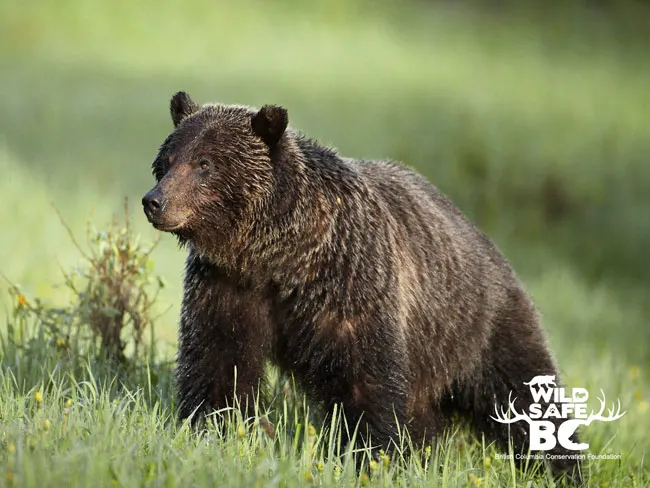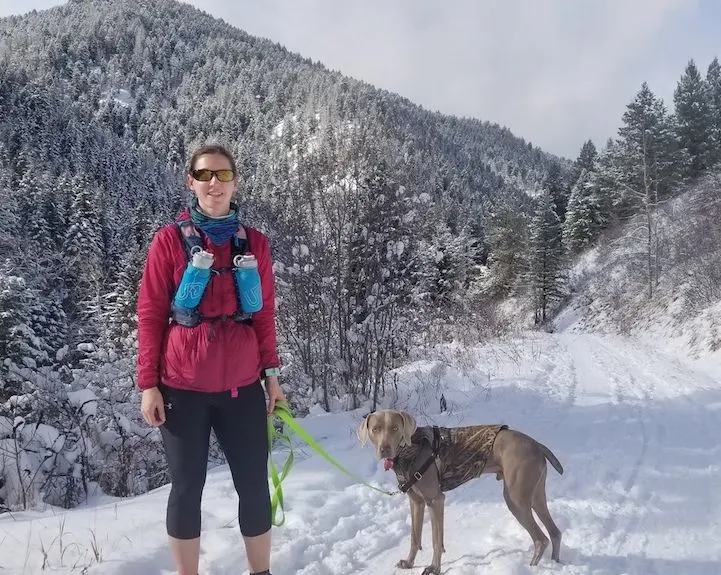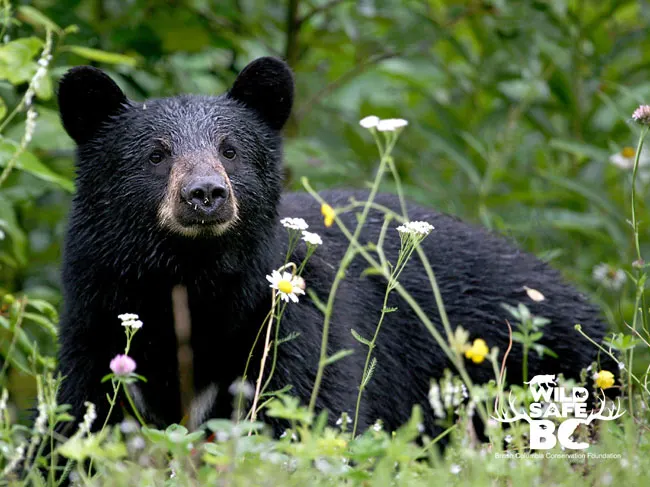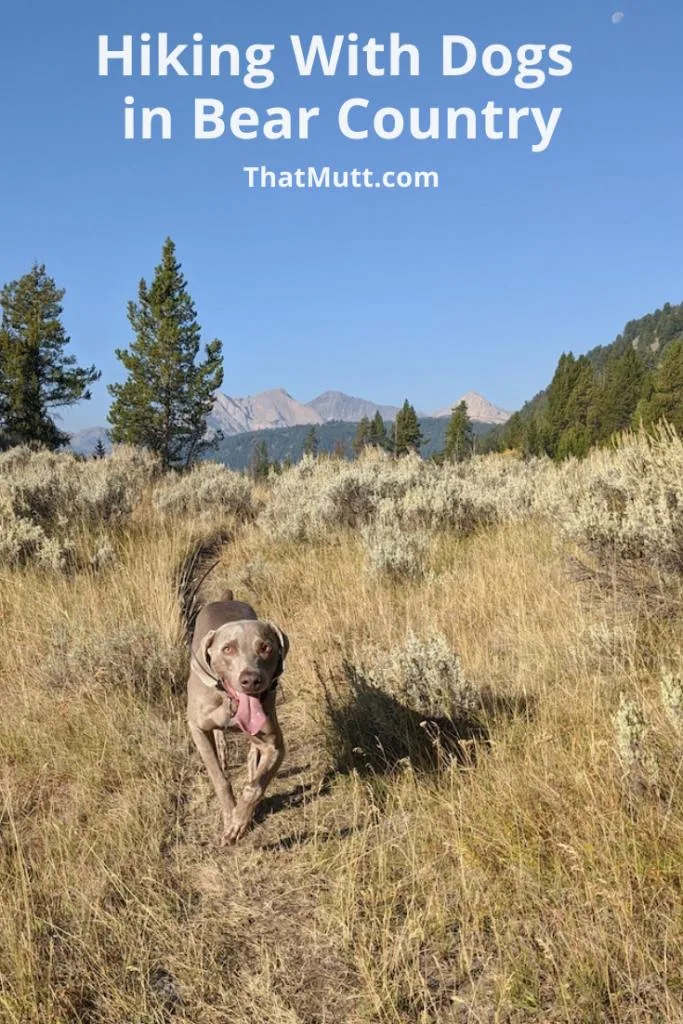Hiking is one of the best activities to do with your dog. Fresh air, freedom, exercise, bonding, training, nature—there are many benefits. But for people hiking in bear country, there are extra safety considerations.
The British Columbia Conservation Foundation has developed a program called WildSafeBC that focuses on reducing human-wildlife conflict.
Vanessa Isnardy is the provincial coordinator for WildSafeBC, and she offered some advice on safely hiking with dogs in bear country.
Different types of bears in North America
There are three bear species in North America: black bears, brown bears and polar bears.
Black bears are found throughout much of North America. They can also have brown coats, despite their name.
Brown bears are often referred to as “Grizzly bears” and that’s what we’ll call them in this article.
Grizzly bears live in western and northern Canada, Alaska, Montana, Wyoming, Washington and Idaho.
Grizzly bears in the Lower 48 states were first listed as threatened in 1975 when there were fewer than 150 in the Yellowstone National Park region, according to the Bozeman (MT) Daily Chronicle.
Today, biologists estimate there are more than 700 grizzly bears in the park.
Safety for hiking with dogs in bear country
Of course it’s possible to enjoy being out with your dog in bear country. With some basic precautions, hikes can be safe for you, your dog and bears.
When in bear country, it is important to do our part to reduce the frequency and intensity of human-bear conflicts.
The best way to stay safe around bears is to avoid a bear encounter in the first place, Isnardy says.
Most bears will avoid humans when they can.
Below are her tips to avoid encountering a bear while hiking with your dog:

1. Keep your dog leashed or under voice control when hiking.
Isnardy says it’s best to keep your dog leashed in the back country or at least under voice control.
This is because bears perceive dogs as a potential threat. Dogs can instigate attacks or defensive behaviors from bears that would not have occurred if the dogs had not been present.
“Most dogs are very unpredictable in how they will react during a bear encounter. It is also unpredictable as to how the bear will respond,” says Isnardy.
“A bear that has been previously harassed by a dog may soon realize that they are a larger animal and stand their ground.”
A 2014 article published in International Bear News found that more than 50 percent of black bear attacks that resulted in human injuries involved dogs.
Should you leash your dog in bear country?
At That Mutt, we are realistic and know that most people do not leash their dogs in the remote back country. But we want people to be aware of the potential risks of off-leash dogs and make the best choice for their situation.
Yes, it is possible for your dog to bark and chase a bear away if you do encounter a bear. However, it is also possible your dog could provoke an attack or lead an angry bear right back to you.
If you encounter a bear while out with your dog, Isnardy says to draw your dog close to you with the leash and try to keep him calm. Barking and lunging can appear threatening to bears. Speak softly and back away from the bear slowly, keeping your dog close to you.
Will my dog alert me of a bear?
Dogs can be an early warning signal, sensing bears or other wildlife that we may not be aware of. But they are not foolproof.
Isnardy cautions, “I have a husky mix myself and sometimes she sees wildlife before I do and sometimes I spot animals that she is unaware of. It is important not to rely too much on our pets for early warning and instead, make noise with our voice when we are on trails.”
2. Watch for signs of bears.
Isnardy advises people to watch for fresh bear scat on trails and scratch marks on trees. If you see these signs, consider choosing a different trail. Also watch for tracks and overturned logs.
3. Make a lot of noise, especially with your voice.
Even if you don’t see evidence of bears, it doesn’t mean they’re not there. When you’re out in bear country, it’s important to let bears know you are around by calling out with your voice frequently – sing or yell.
“If they catch your scent or hear a human nearby, they are likely to avoid you or at least be less surprised. Surprising a bear at close range can lead to a defensive attack,” says Isnardy.
Bear bells on a dog while hiking
“Bear bells” are commonly cited as a bear repellant. These bells attach to your dog’s collar or on a person and the ringing is supposed to alert a bear to your presence—and encourage them to avoid you and your dog.
However, Isnardy warns that while bear bells can’t hurt, they are typically not very loud and their sound may not be recognized as “human.”
Plus, their constant ringing may simply become background noise like other sounds in the forest. When hiking in bear country, she says the best way to tell a bear that you are in the area is with your voice.
4. Be aware of your surroundings in bear country.
Loud, running water or other noises may mask your presence.
Runners or mountain bikers who travel quickly and relatively quietly are more likely to have a surprise encounter with a bear. Slow down when your line of sight is limited and call out often. Be extra cautious around blind turns.
WildSafeBC says on its website to use extra caution where sightlines are poor and in areas of bear habitat. This includes berry bushes with ripe fruit, salmon-bearing streams and other areas bears are known to frequent.
5. Hike in groups.
Isnardy advises having a companion or two.
“The more people there are, the more noise you make. However, do not let group size allow you to become complacent.”
Make sure you still take precautions and follow bear safety guidelines, no matter how many people (or dogs) you’re with.
6. Always carry bear spray.
Whether you’re alone or in a group, you should always carry bear spray when in bear territory and learn how to use it (practice, practice!). Keep it accessible such as on a holster or belt and not buried in your pack. That Mutt recommends the Scat Belt which allows you to hold the spray around your waist.
Bear spray is 90 percent effective in deterring a bear attack when used properly, according to WildSafeBC.
Most experts recommend bear spray for the average person vs. a firearm. However, carrying either or both can be effective as long as you are comfortable using what you carry. Practice, practice, practice.
And if you carry bear spray, keep in mind the direction of the wind is a big factor!
7. Manage your food and trash.
If you’re camping or hiking or living in bear country, keep any potential food sources secure and pack out what you bring in. That includes dog food and treats!

Isnardy explains, “Bears that have lost their natural wariness of people and that have also learned to associate people with a food reward can be especially persistent and at times aggressive. Bears that have accessed garbage in residential areas may become bold and even enter people’s homes or vehicles searching for food.
“To safely coexist with bears, we need to ensure they never gain access to these food sources and learn to associate the places we live with an easy meal.”
While most bears choose the easier route of non-confrontation and leave the area if they sense humans, that can change if a bear has a history of encounters with people and has become comfortable around them.
More tips for hiking with dogs in bear country, from WildSafeBC:
- If you find a carcass, leave the area immediately and notify the conservation service or landowner.
- Take training such as a wildlife awareness and safety course.
- Learn more. Check a park’s website for wildlife alerts or safety considerations. When traveling, check in with locals and visitor centers to find out about local wildlife activity.
See the full list on WildSafeBC’s website here.
What to do if you meet a bear
If you encounter a bear, what to do depends so much on the exact situation, but experts say it’s usually best to stop and stay calm. Do NOT run!
We highly recommend the book “Bear Attacks: Their Causes and Avoidance” by Stephen Herrero. Order a copy! And give a copy to anyone you know who hikes in bear country.
The book is very thorough and looks at a study of attacks made on men and women by grizzly bears and black bears. It covers in detail when you should play dead and when should you fight back, all based so much on the specific situation. Unfortunately, the book does not include advice about dogs and bears.
WildSafeBC also has advice for different scenarios on its website. Their advice is similar for both black and grizzly bears but it’s hard to give general advice because every scenario is different.
If you do encounter a bear, what you do next depends on the bear’s behavior—such as whether it is aware of you, agitated or approaching you, according to WildSafeBC.
When a bear is agitated it will “make noises such as jaw-popping, moaning, woofing and may even stomp the ground or bluff charge.”
Both black and grizzly bears are capable of predatory behavior on humans but this is very rare. Most agitation is defensive—the bear is saying you are too close, and it feels it needs to protect itself, its food or cubs.
Grizzly bears evolved in more open habitat and are more inclined to stand their ground than black bears.
Best reaction to a bear in most cases – stay calm
Generally, your best reaction is to speak softly and calmly and back away slowly, according to WildSafeBC.
If you are in a group, stay together. Do not make direct eye contact but keep the bear in sight. It’s usually not worth climbing a tree—black bears are expert climbers.
Pull out your bear spray and be prepared to use it.
Watch the bear until it leaves. Make sure the bear has a clear escape route. After the bear is gone and it’s safe, make sure there is nothing in the area that will attract bears back again.

What to do if a bear charges you while hiking
If the bear charges, stand your ground and discharge the bear spray when the bear is in range (15-30 feet). Most bluff charges stop short of contact but you may be knocked down.
If a bear knocks you down, the best defense is usually to lie still on your stomach, according to WildSafeBC. This is because the bear just wants to know you are no longer a threat. Protect the back of your head by clasping your hands, and spread your feet slightly apart to avoid getting rolled over.
While grizzly encounters are less common, injuries can be much more severe than from a black bear.
Once the bear feels that you are no longer a threat, the attack will usually stop. Stay still and do not get up until you are sure the bear has left the area.
Again, we highly recommend the book “Bear Attacks: Their Causes and Avoidance”. It analyzes dozens of bear attacks in North America and what the people did right or wrong in each unique situation.
If the bear continues to attack you
“If the attack does not stop and the bear tries to consume you then you are dealing with a predatory attack,” according to WildSafeBC. Both grizzly and black bears are capable of a predatory attack.
In this situation, you must fight off the bear with everything possible, WildSafeBC says. Focus on the bear’s face, eyes and nose. Use your bear spray if you can.
Grizzly bears vs black bears – general info
Grizzly and black bears share similar behaviors and diet, according to WildSafeBC. Both species are active from spring to fall and hibernate during the winter. Cubs are born in the den in mid-winter and the typical social unit is a sow with her cubs.
Bears are solitary animals that only meet to mate or when there is an abundance of food such as during salmon spawning season, says WildSafeBC. They have a hierarchy with large boars (males) at the top and cubs at the bottom.
Both black and grizzly bears are omnivorous animals, and 70 to 80 percent of their diet may be plants.
They are opportunistic and will also consume carrion and take down small mammals.
Isnardy explains, “Coastal bears will take advantage of spawning salmon runs and subalpine berries. Interior bears will seek out the bulbs of lilies and dig up ground squirrels. Large boars, especially grizzlies, will occasionally take down larger prey such as elk.”
While black bears and grizzly bears are similar, there are some important differences.
Black bears evolved in forested habitats and, therefore, one of their defenses is to flee into the forest or send their cubs up a tree. Grizzly bears evolved in more open habitats and are more likely to stand their ground.
Do you have any tips for hiking with dogs in bear country?
Let us know in the comments!
Julia Preston writes for That Mutt about dog behavior and training, working dogs and life on her farm in Ontario, Canada. She has a sweet, laid-back boxer mix named Baxter. She is also a blogger at Home on 129 Acres where she writes about her adventures of country living and DIY renovating.



Amy
Wednesday 14th of August 2024
If there is a bear attacking and your covering your head what do you do with your dog? My dog isn't small enough to hide underneath me.
Richard Lind
Saturday 30th of April 2022
I live in North Carolina so we only have black bears. Our local officials say to always keep your dog on a leash and to never leave it outside ever except on the other end of a leash from you (even in your back yard). This overly restrictive commandment is not practical for me. My two dogs and I enjoy more than anything else climbing the mountain in back of our house (yes it is private land) and they running around while I work the land (pulling up invasive vines mostly). But sometimes there are bears. I used to have a malamute who would bark to alert me to a bear but would stand still. I wish I could teach that skill to my current dogs! Our Boxer mix is more likely to charge a bear; but he being brave and protective doesn't come back to me with his adversary behind him. When they encounter a bear I do a 180 degree turn, head the other way quickly (not running) and call them. In almost every case the bear stays put or goes in the other direction; if there are cubs the mom stays by the tree in which the cubs are. (God help me if the dogs ever actually hurt a cub). One time they tangled with a mom and cub and as I walked away from the cub's tree, I heard rustling brush as mom followed me. That was scary but I cut a wide berth in the woods and left another way, dogs with me. An excellent recall is obviously 100% essential in order to try walking off lead where you may encounter a bear. I carry bear spray but so far thankfully have not needed to use it.
David Kenward
Friday 6th of August 2021
Great tips - all part of being a responsible dog owner. Top tips: keep your dog under your control and ALWAYS carry bear spray.
Troy
Monday 26th of April 2021
Thank you for the tips on how to be aware in bear country when visiting with your dog. We're headed up to the Mogollon Rim area of Arizona this spring, (where there is a healthy population of black bears), so your tips are much appreciated!
Bryson Fico
Saturday 24th of April 2021
These are great safety tips for dogs and people. Placing bells on dog's collars and rolling over, protecting the back of your neck during a predatory attack is wise. I also heard you are supposed to keep your backpack on if you have one. Is one type of bear spray better than another?